Rue Saint-Lazare
The Rue Saint-Lazare is a street in the 8th and 9th arrondissements of Paris, France. It starts at 9 Rue Bourdaloue and 1 Rue Notre-Dame-de-Lorette, and ends at Place Gabriel-Péri and Rue de Rome.[lower-alpha 1]
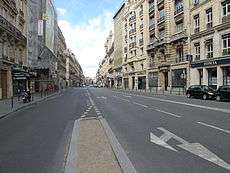 | |
 Shown within Paris | |
| Length | 1,066 m (3,497 ft) |
|---|---|
| Width | 11 to 36 m (36 to 118 ft) |
| Arrondissement | 8th, 9th |
| Quarter | Porcheron |
| Coordinates | 48.876062°N 2.330426°E |
| From | 9 rue Bourdaloue and 1 rue Notre-Dame-de-Lorette |
| To | Place Gabriel-Péri and Rue de Rome |
| Construction | |
| Completion | 17th century |
| Denomination | 1770 |
History
This street already existed in 1700 under the name of rue des Porcherons or rue d'Argenteuil, and connected the villages of Roule and Ville-L’Évêque to the village of Porcherons. In 1734 it was still only lined with few buildings.[1] The present name dates from 1770 and comes from the Maison Saint-Lazare toward which it led (via the rues Lamartine, Bleue, and Paradis) and which had been used as a leprosarium since the Middle Ages; it was converted into the Prison Saint-Lazare in 1793. It stood at the current location of no 117 rue du Faubourg-Saint-Denis, in the 10th arrondissement.
A ministerial decision of 12 Fructidor V (29 August 1797) fixed the minimum width of the street at 10 meters. This width was increased to 11 meters by a royal decree of 3 August 1838. An order of 3 September 1843 declared the public utility of expansion to 20 meters to the right of the properties at numbers 115-121 to create the Cour du Havre.
The Gare Saint-Lazare was built in 1837. An alley, the "Impasse Bony", created in 1826 and located at the site of the Hotel Terminus, was used for unloading luggage.[2] The Cour de Rome, in front of the station on the west side, encompassed the old "Impasse d’Argenteuil", which opened onto the Rue du Rocher.[2]
Notable buildings
- Nos 27-29 (and nos 32-34, Rue de Châteaudun): Two notable buildings, decorated in the style of French architecture of the 16th century, built around 1840. Probably one of the most important collections of this style. The rear facades are visible from the rue de Châteaudun, whose extension in 1862 appears to have cut these buildings off from their garden.[3]
- No 58: Delaroche Hotel built in 1829 in the Tuscan style for the painter Paul Delaroche who lived there 10 years. The colors of the recent restoration claim to reproduce the original polychrome appearance.[3]
- No 60 : Parisian Home of the Duke of Bassano, where he and his wife died.
- No 66 : Émile Zola bought an apartment here, where he installed his mistress Jeanne Rozerot.
- No 87: Avenue du Coq: site of the former castle of the Porcheron family (13th century), which gave its name to the district. Later, it became the property of the Le Cocq family, and gave its name to the impasse which was released in its place.[4]
- No 88: Hotel built for the PLM railway company in 1869 replacing the office of the Bridges and Highways department, built in 1788 by architect François-Nicolas Hole, aka Henry. From 1938 to 1999 it was the headquarters of the SNCF.
- No 108: Hotel Concorde Opéra Paris, former Grand Hotel Terminus of the Gare Saint-Lazare, designed by architect Juste Lisch to welcome visitors to the Exposition Universelle (1889).
- Nos 113-115: Brasserie Mollard: The interior, dated 1894, is by the architect Édouard Niermans. The ceramic tables are by M. Simas.
- No 119: A fast food institution to teach McDonald's employees replaced a Bavarian tavern the Roi de la Bière, with a sign dating it to 1910,[5] whose original façade has been preserved.
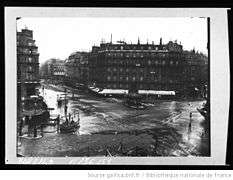 The great flood of Paris in January 1910. Looking to the rue Saint-Lazare from the square Gabriel Péri. The railway station Paris Saint-Lazare is on the left.
The great flood of Paris in January 1910. Looking to the rue Saint-Lazare from the square Gabriel Péri. The railway station Paris Saint-Lazare is on the left.- The Rue Saint-Lazare at the start of the 20th century already had heavy traffic of buses and compressed air trams.
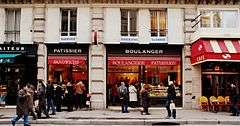 A bakery, Rue Saint-Lazare, Paris 2009
A bakery, Rue Saint-Lazare, Paris 2009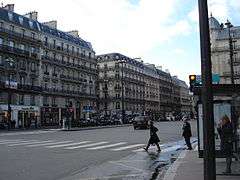 2006 Near Église de la Sainte-Trinité
2006 Near Église de la Sainte-Trinité Former Grand Hôtel Terminus, now Hôtel Concorde-Saint-Lazare
Former Grand Hôtel Terminus, now Hôtel Concorde-Saint-Lazare
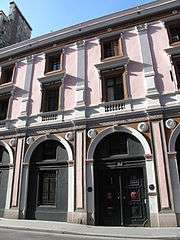 No 58:Delaroche Hotel
No 58:Delaroche Hotel No 88: Former SNCF headquarters
No 88: Former SNCF headquarters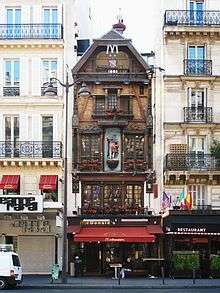 No 119: Roi de la Bière
No 119: Roi de la Bière
References
Notes
- Rue Saint-Lazare once continued to the Rue du Rocher and Rue de l'Arcade.
Citations
- Félix Lazare 1844-1849, p. 370.
- Rochegude 1910, p. 40.
- Pérouse de Montclos 1994, p. 460.
- Rustenholz 2006, p. 647.
- Rochegude 1910, p. 41.
Sources
- "Félix Lazare". Dictionnaire administratif et historique des rues de Paris et de ses monuments. Paris: Imprimerie de Vinchon. 1844–1849.
- Pérouse de Montclos, Jean-Marie (1994). Le Guide du Patrimoine. Paris. Paris: Hachette.CS1 maint: ref=harv (link)
- Rochegude, Félix de (1910). "VIIIe arrondissement". Promenades dans toutes les rues de Paris. Paris: Hachette.CS1 maint: ref=harv (link)
- Rustenholz, Alain (September 2006). Les traversées de Paris. Évreux: Parigramme. ISBN 978-2-84096-400-1.CS1 maint: ref=harv (link)
| Wikimedia Commons has media related to Rue Saint-Lazare (Paris). |
External links
- Histoire de Paris rue par rue, maison par maison, Charles Lefeuve, 1875 (http://www.paris-pittoresque.com/rues/161.htm)